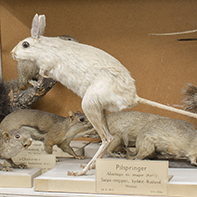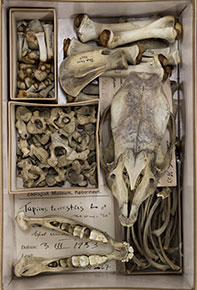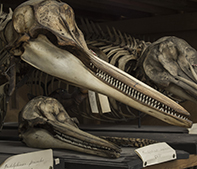Mammal collection

(Photo: Mikkel Høegh Post)
Curator
Collection managers
About the collection
The mammal collection comprises approx 56,000 specimens, the oldest of which date back to 1649. Around 1,600 of the World’s 5,488 (estimated in April 2015) mammal species are represented.
We have impressive series of most Danish and Greenlandic mammals, including terrestrial and marine carnivores (polar bear, Arctic fox, red fox, walrus, seals), rodents (red squirrels), mustelids (Eurasian otter, European badger, martin, polecat, marmot) bovids (musk ox), cervids (reindeer, red deer, roe deer) and bats. The geographic span of our material furthermore includes particularly rich collections from East Africa, Sudan, Southeast Asia, and Brazil (incl. the recent Lagoa Santa material collected by PW Lund in the mid-1880s).
We have a large collection of whale skeletons from Greenland and Denmark (some of which can be experienced in our whale basement), and large series of sperm whale, narwhal, beluga, harbor porpoise and white-beaked dolphin.

(Photo: Mikkel Høegh Post)
Mammal collection in numbers
- Estimated number of specimens: 56,000
- Types: 88
- Digitally available specimens: Only the type specimens can be found online. For the rest of our material, please contact the curators
- Percentage digitized: 36%
Strengths
- Large series of Danish and Greenlandic mammals
- Danish and Greenlandic seals
- North Atlantic cetaceans
- PW Lund recent Lagoa Santa collection (Brazil)
History
The origin of the mammal collection can be traced almost 370 years back in time, to a brilliant mind of his time, Ole Worm (1588-1654). Worm travelled through Europe during his studies, bringing him to Germany, France, Switzerland, Italy and England. He visited many European curiosity cabinets, and these inspired Worm to initiate his own collection.
Back in Denmark, Worm was hired at the University of Copenhagen, where he occupied many different professorships. He introduced a whole new way of teaching, using his expanding collection in his lectures, and he opened up his collection for students and others who where interested. Parts of Worm’s collection exist today, stored in various Danish museums, and 40 of his natural history objects are found the Natural history Museum of Denmark.

(Photo: Mikkel Høegh Post)
While many of Worm’s colleagues relied on reading work by other scientists, Worm pleaded to his students that they should experience the world and obtain knowledge by actual examination. Dissections were one of Worm’s favourite forms of examination, through which he solved many mysteries, such as the misconception about the spontaneous generation of lemmings. Worm dissected lemmings, proving that they were anatomically similar to other rodents, and that they had sexual organs.
Some of Worm’s students carried on the dissection tradition, a tradition that is continued today, in one of the most well-established and well-functioning dissection facilities in the world. In addition to osteological preparation, which is directly linked to the mammal collections, public dissections are undertaken in the dissection, to serve outreach and educational purposes.

(Photo: Mikkel Høegh Post)
